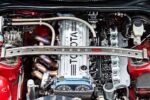Understanding the Cat 3208 Marine Engine
A Brief History
The Cat 3208 marine engine, produced by Caterpillar Inc., has been a staple in the marine industry since its introduction in the late 1970s. Known for its robust design and versatility, the 3208 engine quickly gained popularity among boat builders and marine enthusiasts alike. Originally designed as a diesel engine for various applications, its adaptability made it a prime choice for marine propulsion systems. With a displacement of 320 cubic inches, this V8 engine was engineered to deliver reliable power and efficiency, making it suitable for a range of vessels, from small recreational boats to larger commercial crafts.
Over the years, the Cat 3208 has earned a reputation for its durability and performance. Its simple design allows for easier maintenance and repair, which has contributed to its longevity in the market. However, like any mechanical system, the 3208 is not without its issues. As these engines age, various problems can arise, impacting their performance and reliability.
Understanding the common problems associated with the Cat 3208 marine engine is crucial for boat owners and operators. Whether it’s issues related to fuel delivery, overheating, or mechanical failures, being aware of these potential pitfalls can save time, money, and ensure safe operation on the water. This article will delve into the most prevalent problems faced by the Cat 3208 marine engine, providing insights into troubleshooting and maintenance strategies to keep these engines running smoothly.
Common Problems with the Cat 3208 Marine Engine
The Cat 3208 marine engine, while known for its reliability, can encounter several issues that may affect its performance. Understanding these problems is essential for maintenance and troubleshooting. Below are some of the most common issues faced by owners of the Cat 3208 marine engine.
Overheating Issues
Overheating is a frequent problem with the Cat 3208. This can be attributed to several factors, including:
- Insufficient coolant levels
- Clogged coolant passages
- Faulty water pumps
- Failed thermostats
When the engine overheats, it can lead to severe damage, including warped cylinder heads and blown gaskets. Regularly checking coolant levels and ensuring the cooling system is clean can help mitigate this issue.
Fuel System Problems
Fuel delivery issues can severely impact engine performance. Common fuel system problems include:
- Clogged fuel filters
- Faulty fuel injectors
- Air leaks in the fuel line
These issues can cause poor engine performance, stalling, and difficulty starting. Regular maintenance of the fuel system is crucial to avoid these problems.
Oil Leaks
Oil leaks are another common issue with the Cat 3208. These leaks can occur due to:
- Worn gaskets
- Damaged oil seals
- Poorly tightened fittings
Oil leaks not only reduce engine efficiency but can also pose safety hazards, especially in a marine environment. Regular inspections can help identify and rectify leaks before they become significant problems.
Electrical System Failures
The electrical system in the Cat 3208 can also present challenges. Common electrical issues include:
- Faulty wiring connections
- Defective alternators
- Weak batteries
These failures can lead to starting problems and erratic engine behavior. Ensuring all electrical connections are secure and components are in good working order is essential for reliable operation.
Mechanical Failures
Mechanical failures can occur due to wear and tear over time. Common mechanical issues include:
- Worn piston rings
- Failed bearings
- Timing belt issues
These problems can lead to significant engine damage if not addressed promptly. Regular maintenance checks and timely replacements of worn components are vital to prevent catastrophic failures.
Symptoms and Consequences
Understanding the symptoms associated with these problems can help in early detection and prevention of serious damage. Below is a table summarizing common symptoms and their potential consequences.
| Symptom | Possible Consequence |
|---|---|
| Engine overheating | Warped cylinder heads, blown gaskets |
| Poor acceleration | Clogged fuel filters, faulty injectors |
| Visible oil leaks | Reduced engine efficiency, safety hazards |
| Starting issues | Faulty wiring, weak batteries |
| Unusual noises from the engine | Worn components, potential mechanical failure |




0 Comments